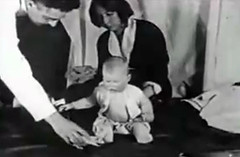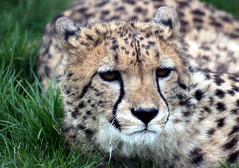| 8421198944 | How we learn | ::associative learning learning that
certain events occur together. The
events may be two stimuli (as in classical
conditioning) or a response and its consequences
(as in operant conditioning).
Put money in a vending machine, push a button get a snack. | | 0 |
| 8421202621 | Psychology's roots | behaviorism or contemporary psychology is the view that psychology
(1) should be an objective
science that (2) studies behavior
without reference
to mental processes. Most research
psychologists today agree with (1)
but not with (2).
:: | | 1 |
| 8421206131 | Psychology's three main levels of analysis | Together, different levels of analysis form an integrated biopsychosocial
approach, which considers the influences of biological, psychological,
and social-cultural factors (FIGURE 1). | | 2 |
| 8421213748 | Did we know it all along | hindsight bias
(also known as the I-knew-it-all-along phenomenon). After the 2007 Virginia Tech massacre of 32 people, it seemed obvious that school officials should have locked down the school (despite its having the population of a small city) after the first two
people were murdered. With 20/20 hindsight, everything seems obvious.! | | 3 |
| 8421216814 | The scientific method | Critical thinking,
theory:an explanation using an integrated set of principles.
Operational definition; a statement of the procedures (operations).
Replication repeating the essence of a
research study, usually with different participants in different situations. | | 4 |
| 8421225809 | Random Sampling | How could you choose a group that would represent the total student population, the whole group you want to study and describe? Typically, you would choose a random sample, in which every person in the entire group has an equal chance of participating. | | 5 |
| 8421229077 | Naturalistic observation | These naturalistic
observations range from watching chimpanzee societies in the jungle, to unobtrusively
videotaping (and later systematically analyzing) parent-child interactions in relationships. | | 6 |
| 8421231563 | Correlation | ::correlation a measure of the extent to which two factors vary together, and thus of how well either factor predicts A statistical measure (the correlation coefficient) helps us figure how closely two things vary together, and thus how well either one predicts the other. | | 7 |
| 8421233582 | Experimentation | ::experiment a research method in which an investigator manipulates one
or more factors (independent variables)
to observe the effect on some behavioror mental process (the dependent variable). By random assignment of participants, the experimenter aims to controlother relevant factors.
::random assignment assigning double-blind procedure an experimental
procedure in which both the
research participants and the research staff are ignorant (blind) about whether
the research participants have received the treatment or a placebo. | | 8 |
| 8421241549 | Independent vs dependent variable | ::independent variable the experimental
factor that is manipulated; the
variable whose effect is being studied.
::dependent variable the outcome
factor; the variable that may change in
response to manipulations of the independent
variable. | | 9 |
| 8421241550 | Neurons | neuron a nerve cell; the basic building
block of the nervous system. Dendrite the bushy,branching extensions. axon the extension of a neuron, ending
in branching terminal fibers, through
which messages pass to other neurons
or to muscles or glands. myelin [MY-uh-lin] sheath a layer of
fatty tissue segmentally encasing | | 10 |
| 8421259193 | How neurotransmitters influence us | |  | 11 |
| 8421263063 | The nervous system | ::peripheral nervous system (PNS)
the sensory and motor neurons that
connect the central nervous system
(CNS) to the rest of the body. |  | 12 |
| 8421267801 | Culture and the self | ::culture the enduring behaviors, ideas,
attitudes, values, and traditions shared
by a group of people and transmitted
from one generation to the next. In a collectivist culture, group identifications
provide a sense of belonging, a set of values, a network of caring individuals, an assurance
of security. | | 13 |
| 8421275123 | Nature, nurture and human diversity | Using twin and adoption studies, behavior geneticists can mathematically estimate
the heritability of a trait. as humans we share a common biological heritage. | | 14 |
| 8421282515 | Peer influence | Peer power As we develop, we play, mate,
and partner with peers. No wonder children
and youths are so sensitive and responsivePart of this peer similarity may result from a selection effect, as kids seek out peers
with similar attitudes and interests. Those who smoke (or don't) may select as
friends those who also smoke (or don't). |  | 15 |
| 8421299665 | Gender and child rearing | As society assigns each of us to a gender, the social category of male or female, the inevitable
result is our strong gender identity, our sense of being male or female. To
varying extents, we also become gender typed families discourage traditional gender
typing, children usually organize themselves into "boy worlds" and "girl worlds,"
each guided by rules for what boys and girls do. | | 16 |
| 8421304912 | Prenatal development | Fewer than half of all fertilized eggs, called zygotes, survive beyond
the first 2 weeks. beginning approximately 37 weeks of the closest human relationship. The zygote's
inner cells become the embryo By 9 weeks after conception, the embryo looks unmistakably human (FIGURE
5.2c). It is now a fetus ( |  | 17 |
| 8421318775 | Cognitive development | Cognition refers to all the mental activities associated with thinking, knowing, remembering,
and communicating First, we assimilate new experiences—we interpret them
in terms of our current understandings (schemas). we also adjust, or accommodate, our schemas to incorporate information
provided by new experiences |  | 18 |
| 8421322769 | Piaget's theory and current thinking | |  | 19 |
| 8421336302 | effortful processing | Effortful processing often
produces durable and accessible memories. ::spacing effect the tendency for distributed
study or practice to yield better
long-term retention than is achieved
through massed study or practice.
::serial position effect our tendency to effortful processing | | 20 |
| 8421340785 | levels of processing | visual encoding the encoding of picture
images.
::acoustic encoding the encoding of
sound, especially the sound of words.
::semantic encoding the encoding of
meaning, including the meaning of | | 21 |
| 8421343954 | Organizing information for encoding | Taking
lecture and text notes in outline format—a type of hierarchical organization—may be helpful | | 22 |
| 8421346428 | Attachment differences | What accounts for children's attachment differences? Placed in a strange situation
(usually a laboratory playroom), about 60 percent of infants display secure attachment.
In their mother's presence they play comfortably, happily exploring their new
environment. When she leaves, they are distressed | | 23 |
| 8421350648 | Adulthood's commitments | dynamics of premarital relationships have changed from decades ago. Both men and women are marring at an older age. | | 24 |
| 8421356784 | Actions affect attitudes | Many streams of evidence confirm that attitudes follow behavior. when we assume a new role we tend to follow the social prescription of that role. | | 25 |
| 8421360783 | Group pressure and conformity | conformity adjusting one's behavior
or thinking to coincide with a group standard |  | 26 |
| 8421364110 | Social facilitation | Social facilitation Skilled athletes often
find they are "on" before an audience. What
they do well, they do even better when people are watching. |  | 27 |
| 8421364111 | social loafing | describe this diminished effort as
social loafing. |  | 28 |
| 8421373089 | Deindividuation | Deindividuation So, the presence of others can arouse people |  | 29 |
| 8421375172 | Group polarization | group polarization the enhancement
of a group's prevailing inclinations
through discussion within the group. |  | 30 |
| 8421378634 | Prejudice | prejudice an unjustifiable (and usually
negative) attitude toward a group and
its members. |  | 31 |
| 8421382823 | How we learn? | ::learning a relatively
permanent change in an
organism's behavior due to experience |  | 32 |
| 8421385832 | Classical conditioning | |  | 33 |
| 8421388400 | Pavlov;s experiments | Pavlov's classic experiment Pavlov presented
a neutral stimulus (a tone) just before
an unconditioned stimulus (food in mouth).
The neutral stimulus then became a conditioned
stimulus, producing a conditioned response |  | 34 |
| 8421393928 | acquisition | acquisition in classical conditioning,
the initial stage, when one links a neutral
stimulus and an unconditioned stimulus
so that the neutral stimulus begins triggering
the conditioned response |  | 35 |
| 8421401224 | extinction and spontaneous recovery | The rising
curve shows that the CR rapidly grows
stronger as the CS and US are repeatedly
paired (acquisition), then weakens as the CS
is presented alone (extinction). After a pause,
the CR reappears (spontaneous recovery |  | 36 |
| 8421401225 | Personality | ::personality an individual's
characteristic pattern of
thinking, feeling, and acting. consistent behavior |  | 37 |
| 8421411004 | The psychodynamic perspective; personality and development | Freud had strong interest in the unconscious. Especially conflicts with the self and levels of personality |  | 38 |
| 8421414229 | Defense Mechanisms | defense mechanisms—tactics
that reduce or redirect anxiety by distorting reality. ::reaction formation psychoanalytic
defense mechanism by which the ego
unconsciously switches unacceptable
impulses into their opposites. Thus, people
may express feelings that are the
opposite of their anxiety-arousing
unconscious feelings. |  | 39 |
| 8421422916 | The neo-freudian and psychodynamic theorists | Alfred Alder The individual feels
at home in life and feels his existence
to be worthwhile just so far as
he is useful to others and is overcoming
feelings of inferiority"
(Problems of Neurosis, 1964)
Karen Horney "The view that women
are infantile and emotional creatures, and
as such, incapable of responsibility and
independence is the work of the
masculine tendency to lower women's
self-respect" (Feminine Psychology, 1932).. |  | 40 |
| 8421430546 | assessing unconscious processess | The TAT This clinician presumes
that the hopes, fears, and interests
expressed in this boy's descriptions
of a series of ambiguous pictures in
the Thematic Apperception Test
(TAT) are projections of his inner |  | 41 |
| 8421437232 | Evaluating the psychoanalytic perspective | self-concept all our thoughts and
feelings about ourselves, in answer to
the question, "Who am I?"
9 in 10 people rated self-esteem as
very important for "motivating a person to work hard and succeed." |  | 42 |
| 8421441008 | The humanistic perspective | The prominence of the humanistic perspective set off a backlash of criticism. First,
said the critics, its concepts are vague and subjective. |  | 43 |
| 8421444638 | Carl rogers person-centered perspective | According to Rogers, people nurture our growth by being genuine—by being open
with their own feelings, dropping their facades, and being transparent and selfdisclosing |  | 44 |
| 8421447644 | classical conditioning generalization | Generalization Pavlov demonstrated
generalization by attaching
miniature vibrators to various
parts of a dog's body. After conditioning
salivation to stimulation of
the thigh, he stimulated other
areas. |  | 45 |
| 8421447645 | discrimination | discrimination in classical conditioning,
the learned ability to distinguish
between a conditioned stimulus and
stimuli that do not signal an unconditioned
stimulus. |  | 46 |
| 8421454356 | extending pavlov's understanding cognitive processes | But Robert
Rescorla and Allan Wagner (1972) showed that an animal can learn the predictability
of an event. |  | 47 |
| 8421464594 | extending pavlov's understanding: biological predispositions | More than the early behaviorists realized,
an animal's capacity for conditioning is constrained by its biology. Each species'
predispositions prepare it to learn the associations that enhance its survival.
elicit similar responses | | 48 |
| 8421472092 | skinners experiments | Skinner's
work elaborated what psychologist Edward L. Thorndike (1874-1949) called the law
of effect: Rewarded behavior is likely to recur
These principles also enabled him to teach pigeons such unpigeonlike
behaviors as walking in a figure 8, playing Ping-Pong, |  | 49 |
| 8421472093 | Shaping behavior | Skinner used shaping, a procedure in which reinforcers, such as
food, gradually guide an animal's actions toward a desired behavior. |  | 50 |
| 8421485889 | Types of reinforcers | Operant
Conditioning Term Description Examples
Positive reinforcement
Negative reinforcement
Add a desirable stimulus
Remove an aversive stimulus
Getting a hug; receiving a paycheck
Fastening seatbelt to turn off beeping |  | 51 |
| 8421488870 | Primary and conditioned reinforcers | Primary reinforcers—getting food
when hungry or having a painful headache go away—are unlearned. They are innately
satisfying. Conditioned reinforcers, also called secondary reinforcers, get their
power through learned association with primary reinforcers |  | 52 |
| 8421508558 | reinforcement schedules | Fixed-ratio schedules
Variable-ratio schedules
Fixed-interval schedules
Variable-interval schedules |  | 53 |
| 8421508559 | Punishment | punishment does the opposite. A punisher is
any consequence that decreases the frequency of a preceding behavior |  | 54 |
| 8421513933 | punishment table 7.3 | |  | 55 |
| 8421517510 | extending skinners understanding: cognition | Skinner died resisting the growing belief that cognitive processes—thoughts, perceptions,
expectations—have a necessary place in the science of psychology and even in
our understanding of conditioning. | | 56 |
| 8421525059 | extending skinners understanding:biological predispositions | #
Latent learning Animals, like people, can
learn from experience, with or without reinforcement.
After exploring a maze for 10 days,
rats received a food reward at the end of the
maze. They quickly demonstrated their prior
learning of the maze |  | 57 |
| 8421525060 | skinner legacy | Skinner's critics objected, saying that he dehumanized people by neglecting their
personal freedom and by seeking to control their actions. Skinner's reply: External
consequences already haphazardly control people's behavior | | 58 |
| 8421530213 | applications of operant conditioning | shaping an operant conditioning procedure
in which reinforcers guide behavior
toward closer and closer approximations
of the desired behavior |  | 59 |
| 8421533391 | contrasting classical conditioning | Through classical (Pavlovian)
conditioning, an organism associates different stimuli that it does not control and
responds automatically (respondent behaviors) (TABLE 7.4). Through operant
conditioning, an organism associates its operant behaviors—those that act on its environment to produce rewarding or punishing stimuli—with their consequences.
Cognitive processes and biological predispositions influence both classical and operant operant conditioning | | 60 |
| 8421540169 | learning by observation | Higher animals, especially humans, can learn without direct experience,
through observational learning, by observing and imitating others |  | 61 |
| 8421542505 | bandura's experiments | Albert Bandura "The Bobo doll follows
me wherever I go. The photographs are
published in every introductory psychology
text and virtually every undergraduate
takes introductory psychology. I recently
checked into a Washington hotel. The
clerk at the desk asked, 'Aren't you the
psychologist who did the Bobo doll experiment?'
I answered, 'I am afraid that will
be my legacy.' He replied, 'That deserves
an upgrade |  | 62 |
| 8421547324 | applications of observational learning | Trainees gain skills faster when they not only
are told the needed skills but also are able to observe the skills being modeled effectively by experienced workers | | 63 |
| 8421547325 | assessing the self | Humanistic psychologists sometimes assessed personality by asking people to fill out
questionnaires that would evaluate self-concept. One questionnaire, inspired by Carl
Rogers, asked people to describe themselves both as they would ideally like to be and as they actually are. Ideal vs actual |  | 64 |
| 8421549905 | assessing traits | ::trait a characteristic pattern of behavior or a disposition to feel and act,
as assessed by self-report inventories and peer reports
Minnesota Multiphasic Personality Inventory (MMPI) the most widely
researched and clinically used of all personality
tests. Originally developed to identify emotional disorders (still considered
its most appropriate use) |  | 65 |
| 8421552969 | learned helplessness vs. personal control | personal control the extent to which
people perceive control over their environment
rather than feeling helpless ::external locus of control the perception
that chance or outside forces
beyond your personal control determine
your fate.
::internal locus of control the percep |  | 66 |
| 8421562360 | internal versus external locus of control | ::learned helplessness the hopelessness
and passive resignation an animal
or human learns when unable to avoid
repeated aversive events. good health is luck. when try to be healthy external locus | | 67 |
| 8421566159 | optimism versus pessimism | optimism
If positive thinking in the face of adversity pays dividends,
so, too, can a dash of realism (Schneider, 2001). Self-disparaging explanations of
past failures can depress ambition, but realistic anxiety over possible future failures
can fuel energetic efforts to avoid the dreaded fate
Pessimism
Research on
learned helplessness evolved into research on the effects of optimism
and pessimism, which led to a broader positive psychology | | 68 |
| 8421566160 | exploring the self | focusing on positive outcomes to reach future goals. The possible self! |  | 69 |
| 8421575206 | The benefits of self esteem | In contemporary psychology, the self is assumed to be the center
of personality, the organizer of our thoughts, feelings, and
actions. good behavioral traits |  | 70 |
| 8421577977 | self serving bias | The self-serving bias leads us to perceive ourselves favorably,
often causing us to overestimate our abilities and underestimate
our faults. |  | 71 |
| 8422657503 | defense mechanisms | Freud proposed that the ego protects itself with defense mechanisms—tactics
that reduce or redirect anxiety by distorting reality. Here are seven examples.
::regression psychoanalytic defense
mechanism in which an individual faced
with anxiety retreats to a more infantile
psychosexual stage, where some psychic |  | 72 |
| 8425531935 | Motor development | Triumphant toddlers Sit, crawl, walk, run—
the sequence of these motor development
milestones is the same the world around,
though babies reach them at varying ages. stages of maturation | | 73 |
| 8425960806 | obedience | ::informational social influence influence
resulting from one's willingness to
accept others' opinions about reality |  | 74 |
| 8426161252 | exploring the unconscious | free association in psychoanalysis, a
method of exploring the unconscious in
which the person relaxes and says whatever
comes to mind, no matter how trivial
or embarrassing.
::psychoanalysis Freud's theory of personality
that attributes thoughts and
actions to unconscious motives and conflicts;
the techniques used in treating
psychological disorders by seeking to
expose and interpret unconscious |  | 75 |
| 8426174655 | The psychoanalytic perspective | identification the process by which,
according to Freud, children incorporate
their parents' values into their developing superego fixation according to Freud, a lingering
focus of pleasure-seeking energies at an
earlier psychosexual stage, in which conflicts were unresolved. |  | 76 |
| 8426401893 | operant conditioning | operant conditioning a type of learning
in which behavior is strengthened if
followed by a reinforcer or diminished if
followed by a punisher. |  | 77 |




























































































